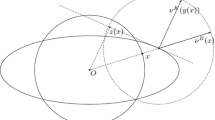Abstract
Path-based cardinal characterizations of closed and nonempty sets are defined, and their basic properties are detailed. Differential properties and applications to performance measurement are considered.



Similar content being viewed by others
Notes
A translation of an article published in Russian in 1924.
Part a is a special case of a result reported by Aczél (1966, p.18). Therefore, I only prove part b by adapting Aczél’s proof of a.
The hypograph of \(f:{{\mathbb{R}}}^{N}\to {\mathbb{R}}\) is \(\left\{\left(x,y\right):f\left(x\right)\ge y\right\}\).
My thanks to Bert Balk and Rolf Färe for comments that suggested this example.
The remainder of this paragraph is drawn almost word for word from Johnson (1913, pp. 506-507). The changes I have made are notational and omit some verbiage.
Carlson (1939, see pp. 16-17), who lists Johnson (1913) as his earliest source on the elasticity of production defines the function coefficient (elasticity of production), as a directional derivative without using that specific terminology. Courant (1936), which represents a translation of an earlier German work, discusses the concept as a derivative in a direction.
A more ordinary convention in welfare economics is to define the equivalent benefit measure as the negative of \(RS\left({x}^{1},{x}^{0},{C}^{1}\right)\) on the presumption that C0 is the original indifference set.
In the same setting, the compensating and equivalent variations differ.
Bennet (1920), Fisher (1921) established a convention followed by, among others, Caves et al. (1982), and Chambers (1996, 2002). Aczél (1990) shows that the geometric mean is the only merged relative score that satisfies multiplicativity, positive homogeneity, and symmetry. I follow the convention, while noting that further investigation is required to determine whether Aczél’s axioms are reasonable in a path-based setting.
A favorite saying my father often quoted on our walks in the woods that I later learned is best attributed to the the 18th century English landscape architect, William Kent.
References
Aczél J (1966) Lectures on functional equations and their applications. Academic Press, New York
Aliprantis CD, Border KC (2007) Infinite dimensional analysis: a Hitchhiker’s guide (3d Ed.). Springer-Verlag, Berlin
Allais M (1943) Traité d’Économie pure. Imprimerie Nationale, Paris
Bennet MK (1920) The theory of measurement of changes in cost of living. J R Stat Soc 83:445–62
Berge C (1959) Espaces topologiques: fonctions multivoques. Dunod, Paris
Blackorby C, Donaldson D (1980) A theoretical treatment of indices of absolute inequality. Int Econ Rev 21(1):107–36
Bonnesen T, Fenchel W (1934) Theorie der Konvexen Körper. Springer, Berlin
Bonnesen T, Fenchel W (1987) Theory of convex bodies. Idaho Associates, Moscow
Briec W, Lesourd J-B (1999) Metric distance and profit functions: Some duality results. J Optim Theory Appl 101:15–33
Carlson S (1939) A study on the pure theory of production. P.S. King & Son, Ltd., London
Caves DW, Christen LR, Diewert WE (1982) The economic theory of index numbers and the measurement of input, output, and productivity. Econometrica 50:1393–1414
Chambers CP, Miller A (2014) Inefficiency measurement. Am Econ J: Microecon 6:79–92
Chambers RG (1996) Exact nonradial input, output, and productivity measurement. Working Paper, Agricultural and Resource Economics, University of Maryland
Chambers RG (2002) Exact nonradial input, output, and productivity measurement. Econ Theory 20:751–765
Chambers RG, Färe R (1998) Translation homotheticity. Econ Theory 11:629–41
Courant R (1936) Differential & integral calculus; Volume II. Blackie & Son Ltd, London
Debreu G (1951) The coefficient of resource utilization. Econometrica 19(3):273–92
Färe R, Lovell CAK (1978) The structure of technical efficiency. J Econ Theory 19:150–162
Hougaard JL, Keiding H (1998) On the functional form of an efficiency index. J Prod Anal 9:103–11
Johnson WE (1913) The pure theory of utility curves. Econ J XXIII:483–513
Konüs AA (1939) The problem of the true index of the cost of living. Econometrica 7:10–29
Luenberger DG (1992) Benefit functions and duality. J Math Econ 21:461–81
Luenberger DG (1996) Welfare from a benefit viewpoint. Econ Theory 7:445–62
Malmquist S (1953) Index numbers and indifference surfaces. Trabajos De Estatistica 4:209–42
Minkowski H (1911) Theorie der Konvexen Körper, Insbesondere Begründung ihres Oberflächenbegriffs. Gesammelte Abhandlungen II, Leipzig
Moulin H (1988) Axioms of cooperative decision making. Cambridge University Press, Cambridge
Shephard RW (1953) Cost and production functions. Princeton University Press, Princeton, NJ
Thomson W, Myerson RB (1980) Monotonicity and independence axioms. Int J Game Theory 9:37–49
Acknowledgements
This paper was prepared for the Plenary Session of the European Workshop on Efficiency and Productivity Analysis, Porto, 2022 honoring Shawna Grosskopf and Rolf Färe as the winners of the 2022 Lifetime Achievement Award. My thanks to Chris Chambers, Bert Balk, Rolf Färe, and Walter Briec for comments on earlier versions.
Author information
Authors and Affiliations
Corresponding author
Ethics declarations
Conflict of interest
The author declares no competing interests.
Additional information
Publisher’s note Springer Nature remains neutral with regard to jurisdictional claims in published maps and institutional affiliations.
Rights and permissions
Springer Nature or its licensor (e.g. a society or other partner) holds exclusive rights to this article under a publishing agreement with the author(s) or other rightsholder(s); author self-archiving of the accepted manuscript version of this article is solely governed by the terms of such publishing agreement and applicable law.
About this article
Cite this article
Chambers, R.G. Path-based set representations. J Prod Anal 60, 249–256 (2023). https://doi.org/10.1007/s11123-023-00691-2
Accepted:
Published:
Issue Date:
DOI: https://doi.org/10.1007/s11123-023-00691-2




